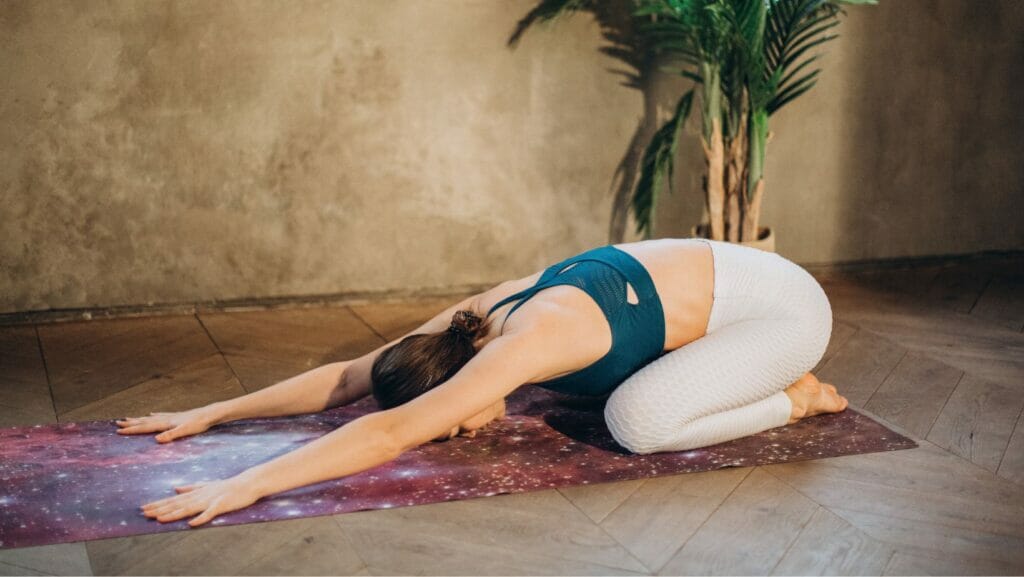
Restorative Yoga for Resetting the Mind, Body, and Spirit
Life often feels like a constant cycle of constructing, deconstructing, planning, and reacting. Our thoughts race, our to-do lists grow, and the hours in each day rarely feel sufficient. Restorative yoga gives us a way to pause. With just a few simple postures, you can reset your nervous system, reenergize your body, and reconnect with your spirit.
This practice is accessible to everyone and can be done at home with a few basic props: two blocks, a blanket, and a bolster or large pillow.
Pose 1: Supported Reclining Bound Angle Pose
This first posture creates deep opening and resets your entire system.
How to Set Up
Stand your first block at its tallest height. Place the second block in front of it at the middle height, leaving a small space between them. Rest your bolster or pillow diagonally across both blocks so it forms a stable ramp. Give it a firm pat to ensure it’s steady.
Next, fold your blanket into a large rectangle and place it beneath your hips to add cushion, warmth, and support. This encourages circulation through the hip joints and psoas muscles.
Lower your spine onto the bolster and allow the soles of your feet to come together naturally. Place your left hand over your heart and your right hand on your belly. Begin to follow the rhythm of your natural breath. Feel your belly and chest rise with each inhale and soften as you exhale, like a gentle breeze or a rolling ocean wave.
Remain here for 20 minutes, allowing your body and mind to reset—equivalent to the restfulness of a two-hour nap.
Benefits
-
Relieves nausea, indigestion, constipation, and anxiety
-
Reduces tension in the head, neck, and shoulders
-
Releases emotional stress from the heart center
-
Encourages oxygenated blood flow to the digestive organs
-
Stimulates the feet, hips, flexors, and psoas to release stored tension
Pose 2: Supported Side-Lying Twist for Restful Sleep
If you struggle with sleep, this pose helps recenter your energy and guide you toward deep rest.
How to Set Up
Place your first block at the middle height beneath the base of your neck (not near your ear). This placement lengthens the vagus nerve and encourages the nervous system to relax.
Lie fully onto one hip on top of your folded blanket. Slip your bottom arm or shoulder underneath you so it connects with the floor. Draw your knees toward your chest and open them slightly. Place your bolster between your thighs—not your knees—to release pressure from the sciatic nerve and open the groin.
Drape your top arm over the blanket and allow your palm or forearm to rest on your second block in front of the bolster. Once you settle, let your entire body become heavy as gravity takes over. With your mouth closed, soften your tongue and breathe through your nose. Fill your lungs slowly and gently press the breath out from your navel.
Ten slow breaths will begin to relax your mind, soften your muscles, and prepare your body for deep, restorative sleep.
Benefits
-
Reduces stress and anxiety
-
Calms the nervous system
-
Encourages full-body breathing
-
Opens the ribcage and lengthens the diaphragm
-
Relieves tension in the shoulder blades, rotator cuff, and chest
Pose 3: Block-Supported Supine Release for Digestion
When digestion feels stagnant or the urinary bladder tract is uncomfortable, this pose creates space and movement.
How to Set Up
Place a block under each foot to gently raise your knees. Roll your blanket into a small bolster and slide it underneath your psoas muscles and lower spine.
Take your time adjusting—wiggle or shift until your vertebrae settle comfortably onto the support. Spread your palms wide and rest them on your lower belly. Relax your head, neck, and shoulders.
Allow your belly to fill with breath, drawing air up into your chest and toward your collarbones. As you exhale, let your heart soften downward and gently press your belly to release stale air from your system.
Benefits
-
Stimulates the bowels
-
Releases pressure from the spine
-
Balances and supports the urinary bladder
-
Relieves tension in the head, neck, and shoulders
